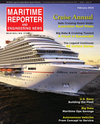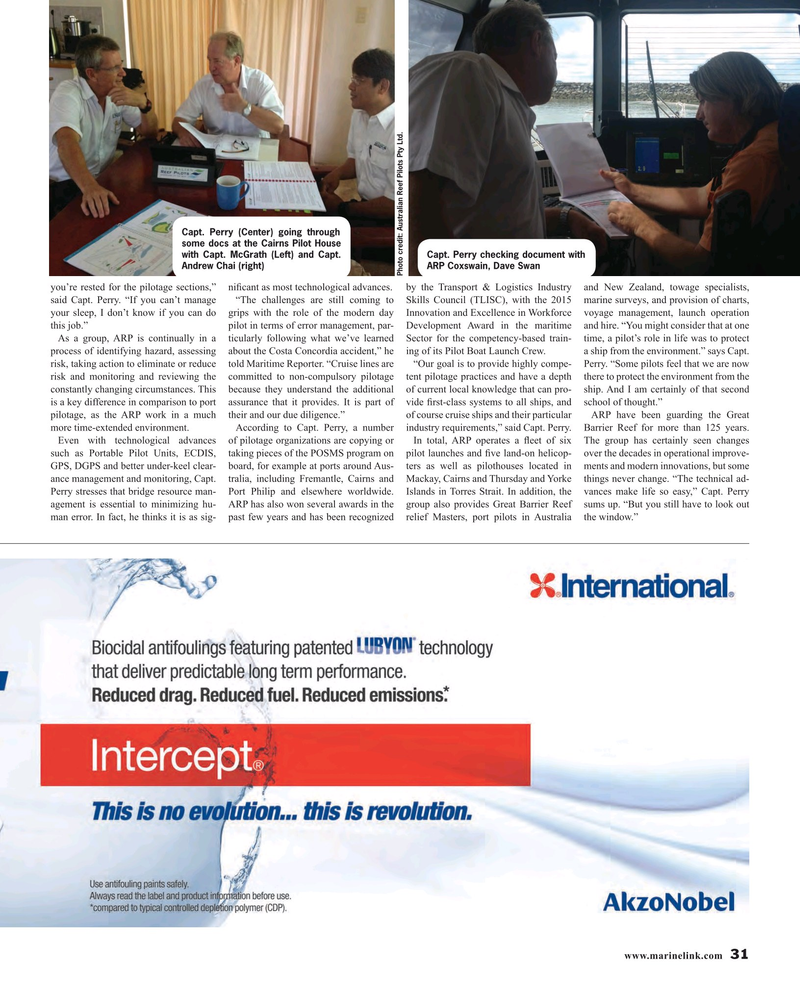
Page 31: of Maritime Reporter Magazine (February 2016)
Cruise Ship Technology Edition
Read this page in Pdf, Flash or Html5 edition of February 2016 Maritime Reporter Magazine
Capt. Perry (Center) going through some docs at the Cairns Pilot House with Capt. McGrath (Left) and Capt. Capt. Perry checking document with
Andrew Chai (right) ARP Coxswain, Dave Swan
Photo credit: Australian Reef Pilots Pty Ltd.
you’re rested for the pilotage sections,” ni? cant as most technological advances. by the Transport & Logistics Industry and New Zealand, towage specialists, said Capt. Perry. “If you can’t manage “The challenges are still coming to Skills Council (TLISC), with the 2015 marine surveys, and provision of charts, your sleep, I don’t know if you can do grips with the role of the modern day Innovation and Excellence in Workforce voyage management, launch operation this job.” pilot in terms of error management, par- Development Award in the maritime and hire. “You might consider that at one
As a group, ARP is continually in a ticularly following what we’ve learned Sector for the competency-based train- time, a pilot’s role in life was to protect process of identifying hazard, assessing about the Costa Concordia accident,” he ing of its Pilot Boat Launch Crew. a ship from the environment.” says Capt. risk, taking action to eliminate or reduce told Maritime Reporter. “Cruise lines are “Our goal is to provide highly compe- Perry. “Some pilots feel that we are now risk and monitoring and reviewing the committed to non-compulsory pilotage tent pilotage practices and have a depth there to protect the environment from the constantly changing circumstances. This because they understand the additional of current local knowledge that can pro- ship. And I am certainly of that second is a key difference in comparison to port assurance that it provides. It is part of vide ? rst-class systems to all ships, and school of thought.” pilotage, as the ARP work in a much their and our due diligence.” of course cruise ships and their particular ARP have been guarding the Great more time-extended environment. According to Capt. Perry, a number industry requirements,” said Capt. Perry. Barrier Reef for more than 125 years.
Even with technological advances of pilotage organizations are copying or In total, ARP operates a ? eet of six The group has certainly seen changes such as Portable Pilot Units, ECDIS, taking pieces of the POSMS program on pilot launches and ? ve land-on helicop- over the decades in operational improve-
GPS, DGPS and better under-keel clear- board, for example at ports around Aus- ters as well as pilothouses located in ments and modern innovations, but some ance management and monitoring, Capt. tralia, including Fremantle, Cairns and Mackay, Cairns and Thursday and Yorke things never change. “The technical ad-
Perry stresses that bridge resource man- Port Philip and elsewhere worldwide. Islands in Torres Strait. In addition, the vances make life so easy,” Capt. Perry agement is essential to minimizing hu- ARP has also won several awards in the group also provides Great Barrier Reef sums up. “But you still have to look out man error. In fact, he thinks it is as sig- past few years and has been recognized relief Masters, port pilots in Australia the window.” www.marinelink.com 31
MR #2 (26-33).indd 31 2/3/2016 10:42:03 AM

 30
30

 32
32
